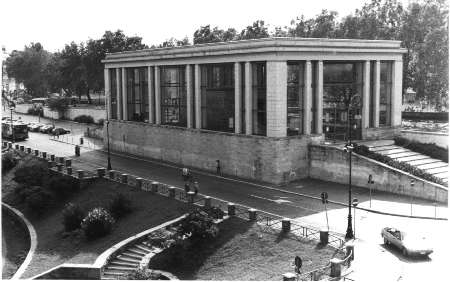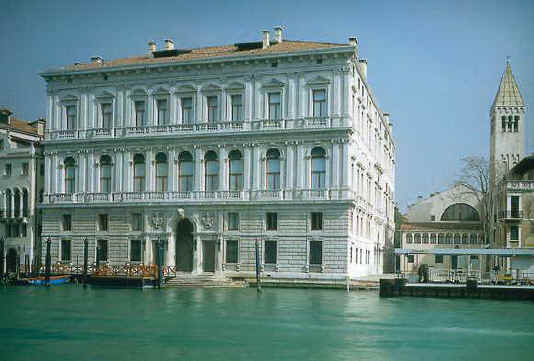European Museums in the News
 Former building for the Ara Pacis, designed by Vittorio Ballio Morpurgo |
 New Museo dell'Ara Pacis, designed by Richard Meier, opened April 2006 |
When I was in Rome last spring, I walked by the site of the Ara Pacis. American starchitect Richard Meier has built a new museum around the Augustan altar of peace, which was in mid-construction when I was there. Alan Riding's article (Richard Meier's New Home for the Ara Pacis, a Roman Treasure, Opens, April 24) in the New York Times reports that the museum, while not quite finished, has opened. The history of this most remarkable monument is fascinating: built by order of the Roman Senate in honor of the Emperor Augustus in 9 B.C., dismantled during the Barbarian attacks on Rome, miraculously tracked down in numerous pieces and rebuilt. It would probably make an interesting book, tracking a cultural treasure through the vicissitudes of time. Riding does a good job of summarizing the more interesting parts, especially its association with Mussolini and the attempt by the Fascists in Italy to associate themselves with Rome's imperial past:
The altar, which was placed in the Campus Martius, or the field of war, was probably destroyed after Rome fell to the Barbarians. But early last century, parts were traced to museums in Florence and Rome (as well as the Louvre in Paris) and other pieces were found in excavations. In the late 1930's, Mussolini ordered the altar's reconstruction and installed it in a building designed by Vittorio Ballio Morpurgo beside the Tiber. Mussolini's motivation was unambiguous: he saw himself as a new Augustus. A wall of Morpurgo's building carried the text of "Res Gestae Divi Augusti," or "Deeds of the Divine Augustus," the emperor's memoirs recounting his triumphs. (This wall is the only piece of the old building retained by Mr. Meier.) Such was Mussolini's pride in his "new" Ara Pacis that he included it in Hitler's tour of Rome in 1938.This would be an interesting art parallel to the question of music like Wagner's, similarly embraced by a fascist dictator. This site has lots of images of the new building, and the Museo dell'Ara Pacis finally has an official Web site.
In that sense, then, the Ara Pacis has now been rescued from its Fascist association, if not from politics. Mr. Rutelli, himself a center-left politician, invited criticism when he chose Mr. Meier as the project's architect without an open competition. The city council eventually approved the plan, but things moved slowly. Finally, in 2000, after a protective structure was built around the Ara Pacis, Morpurgo's building was demolished.
 Last year, I followed the developments around French billionaire François Pinault's plan to build a major modern art museum, to house his own extensive collection, on the Île Séguin, the former site of a Renault plant. Bureaucratic delays drove Pinault to abandon that plan, electing instead to buy the Palazzo Grassi in Venice. That Baroque palace has just reopened, after a redesign by architect Tadao Ando, who was originally hired to create the museum on the Île Séguin. Its main exhibit is called “Where Are We Going?”: Selections from the François Pinault Collection, and it features some of the big names he has bought over the years, especially Jeff Koons, who was spotted in the museum at the opening. An article (Pinault's Venetian Palazzo Opens With Giant Dog, Nasty Photos, April 28) by Martin Gayford for Bloomberg News has a full report:
Last year, I followed the developments around French billionaire François Pinault's plan to build a major modern art museum, to house his own extensive collection, on the Île Séguin, the former site of a Renault plant. Bureaucratic delays drove Pinault to abandon that plan, electing instead to buy the Palazzo Grassi in Venice. That Baroque palace has just reopened, after a redesign by architect Tadao Ando, who was originally hired to create the museum on the Île Séguin. Its main exhibit is called “Where Are We Going?”: Selections from the François Pinault Collection, and it features some of the big names he has bought over the years, especially Jeff Koons, who was spotted in the museum at the opening. An article (Pinault's Venetian Palazzo Opens With Giant Dog, Nasty Photos, April 28) by Martin Gayford for Bloomberg News has a full report:The inaugural display at the Pinault Grassi is huge -- it would be quicker to cite the major contemporary artists who aren't included than those who are. You don't get much feel of an individual taste at work as you do with Charles Saatchi, who is in some ways an Anglo-Saxon equivalent to Pinault. This looks like collecting by consensus. Similarly, the new interiors give the impression that someone has tried to shoe-horn bits of Tate Modern or MoMA into the venerable palazzo. There are, nonetheless, some spectacular things on display. Outside, a magenta "Balloon Dog" by Jeff Koons is placed next to the Grand Canal like an updated Lion of St. Mark's. The building's facade has been covered with a network of wires conceived by the Danish artist Olafur Eliason that shimmer with light when the sun goes down.Two years ago, I wrote about the expansion of the Museo Thyssen-Bornemisza in Madrid. The museum may now belong to the government of Spain, along with the remarkable collection loaned by the Thyssen-Bornemisza family, but the grand lady herself, Baroness Carmen Thyssen (a former Spanish beauty queen who was the Swiss noble scion's fifth wife), still feels some propietary sense of duty, according to an article (Baroness plans Prado road change protest, April 25) by Giles Tremlett for The Guardian:
Inside, you discover that Pinault, whose private holding company controls the auction house Christie's International, has gone in for minimalism on a large scale. Indeed, the enormous checkerboard of colored metal plates by Carl Andre that covers the floor of the courtyard is the biggest specimen of minimalism I have ever seen. Upstairs, you find a roomful of Donald Judd boxes and another of all-white Robert Ryman paintings.
Pinault, 69, has even greater quantities of a very different movement in art from the past two decades. It does not have an official name, but you might dub it ``Utterly-Disgustingism.'' There is a room of photographs by Cindy Sherman depicting mannequins constructed of nastily rearranged body parts and sexual organs. It ought to carry a warning. No child nor anyone who is remotely sensitive should enter. Another distressing sight is David Hammons's "High Level of Cats," which shows three taxidermed pets seated on giant drums. How did the poor animals get there?
Spanish art collector Baroness Carmen Thyssen threatened yesterday to chain herself to a tree on Madrid's most emblematic street, the Paseo del Prado, to stop proposed building works outside a museum of valuable paintings donated by her family. The baroness said a redesign of the street, planned to keep traffic away from the nearby Prado museum, would leave her own museum choking in exhaust fumes. "They want to put a motorway in front of us and, what's more, they will do it by cutting down a unique line of trees," she said.A Spanish baroness chained to a tree? If it happens, I think a performance artist like Jean-Lambert Wild should go to Madrid and make the event into an artistic happening.





















































No comments:
Post a Comment